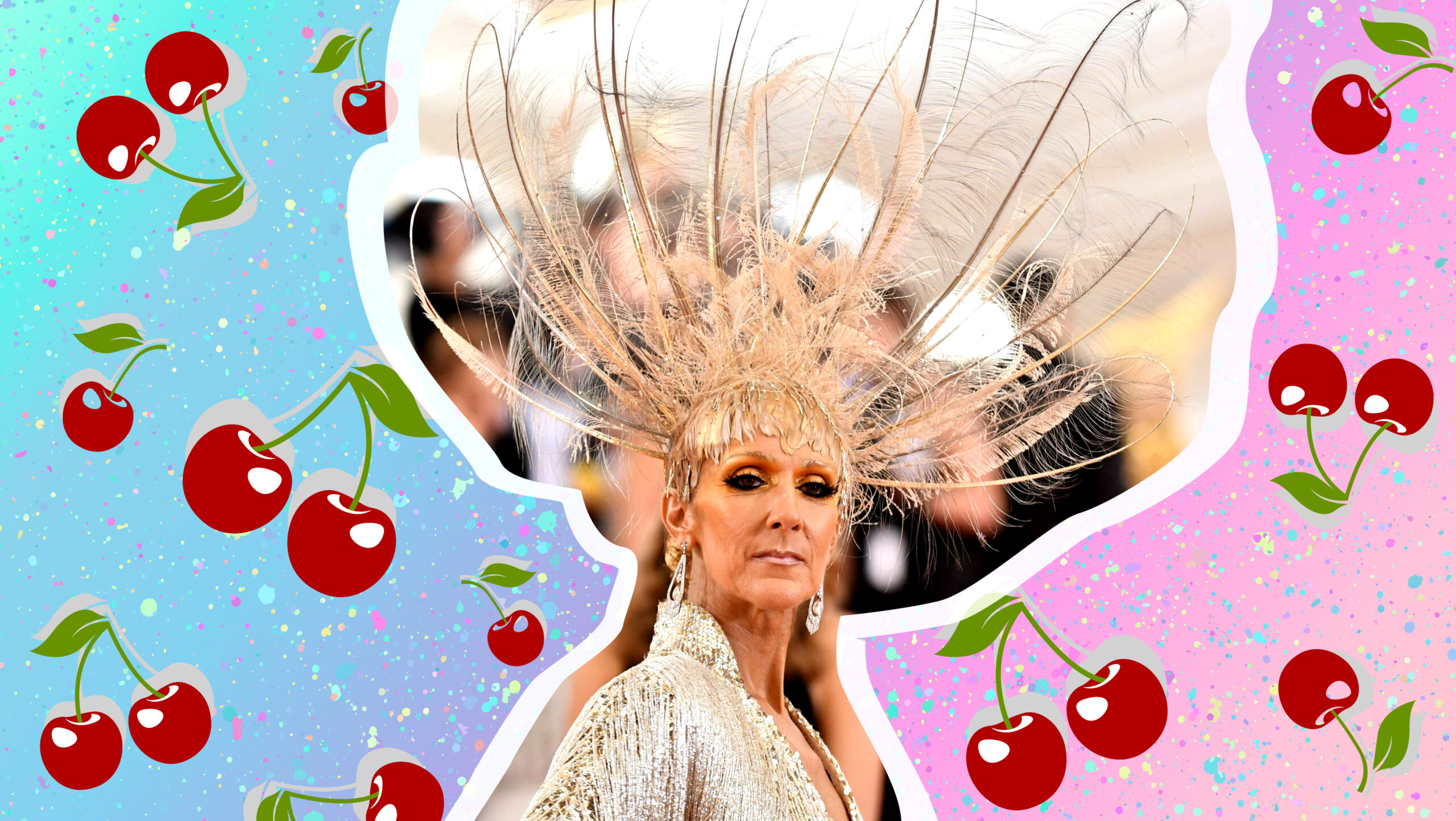Céline Dion, Québécoise goddess and the queen of our hearts, nearly showed up to the camp-themed 2019 Met Gala outfitted for camping.
In her Ziegfeld Follies-inspired Oscar de la Renta ensemble, dripping floor-length, champagne-beaded fringe, she told E!, “I was ready to camp and sleep all night.”
Dion’s cheerful admission was, of course, the very essence of camp itself — a beautiful irony not lost on social media’s huddling masses. What could be more camp, more winking in its subversion of innocence, than one of our greatest living embodiments of camp insisting she actually didn’t know what “camp” meant? In that fateful moment, it’s possible some of you felt the seismic intimation of a rumble as the minds of so many gay men and armchair semioticians collectively exploded.
Our idols are what we make them, and in that sense, Céline Dion has been renewed. The Dion of chest-beating, adult contemporary omnipresence throughout the 1990s is not today’s late-2010s diva stumbling into high-concept couture. When journalist Carl Wilson proposed, in his 2007 book Let’s Talk About Love: A Journey to the End of Taste, that the hordes of music snobs give Céline a chance, it was the kind of argument that demanded a 176-page defence.
And then everything changed. Three years after issuing an expanded edition of Let’s Talk About Love (updated further with the subtitle “Why Other People Have Such Bad Taste”), Wilson assessed, rather than made a case for, Dion’s coolness in Maclean’s. The Atlantic declared that Céline Dion had saved the 2017 Billboard Music Awards with “pop opulence so well-executed that it transcends kitsch.” Drake announced his not-totally-joking intention to get a tattoo of her face. In the age of Trump, amid a memeified zeitgeist and pop culture’s accelerated queering, it was clear that a new era had dawned: a Célinaissance.
Something else happened, too. As she leaned into her new role as quirky pop-art matriarch of the people, the balladeeress from Charlemagne, Quebec, quietly emerged from her chrysalis as a lesbian icon. At least, maybe.
To be able to declare with absolute certainty that someone is a lesbian icon, one must first pin down some unifying thesis for what a lesbian icon even is. That, it turns out, can be tough.
There are entire academic disciplines devoted to the cultural construction of fandom, and plenty of queer theory journal entries about the ongoing role of diva worship in constructing gay male identity. (This one features a full-on ethnographic survey whose subjects self-identify as “obsessed” Lady Gaga fans.) “Judy Garland as gay icon” is a full Wikipedia page, with distinct subsections to explain “Garland as camp,” “Friend of Dorothy” and the potential link between Garland’s rendition of “Over the Rainbow” and the LGBTQ2 movement’s adoption of the rainbow flag. Meanwhile, RuPaul’s Drag Race has almost completed its 11th season.
People, by and large, know a gay icon when they see one. That is, they can spot a gay male icon. We have adjectives to associate with its dominant iteration: “flamboyant,” “extra,” “fabulous.” As a subversion of the hetero-masculine ideal of stoic solitude, the gay icon is loud, theatrical and a bit much. Céline Dion, who actualized the 1990s sonic equivalent of a pulp romance paperback cover, fits the paradigm so neatly that it feels condescending to point out why.
“Who could forget that Dion attended the 1999 Oscars wearing not only a white John Galliano tuxedo, but a white John Galliano tuxedo with the jacket on backwards?”
What a lesbian icon looks like — what “lesbian icon” even means — though, isn’t just ambiguous but totally underexplored. Sure, there seems to be at least some consensus on the lez-ness of certain entities and artifacts: cats; astrology; softball. Plausible cases have been made for others: former boy-bander Harry Styles, for his gentle masculinity and love of flowered shirts; the moon, for its goddess Diana, deity of Big Sapphic Energy. Male performers like Zayn Malik, Prince and Benedict Cumberbatch have become realized, anew, as drag king inspiration, their respective masculinities at once on-the-nose and queer, easily absorbed into a knowing pastiche of quotidian gender performance.
Then there are “dykons”: celebrities, usually women, who may or may not be gay themselves but have, for one reason or another, been adopted into the loose pantheon of lesbian iconography. Maybe they’ve played gay for pay on the silver screen, or they’ve been rumoured to be gay themselves — actress Gina Gershon, Queen Latifah and Dolly Parton are among the anointed. Maybe they look damn fine in a suit. Maybe they’re Hillary Clinton.
Céline Dion meets at least some of these criteria. Over the years, her sexuality has been the subject of speculation and wishful thinking (though her near three-decade relationship with former manager René Angélil, cut short by his death in 2016, was by every indication one of deep mutual devotion). And who could forget that Dion attended the 1999 Oscars wearing not only a white John Galliano tuxedo, but a white John Galliano tuxedo with the jacket on backwards?
A deeper dive into Dion’s early-career aesthetic choices surfaces other hints, as Autostraddle recently pointed out. “In the early 1990s, Canadian pop music gave questioning queer girls an icon who performed what they couldn’t yet express: angsty, apprehensive subtexts about the wrong kind of love sometimes being so, so right sung by a diva in is-she-or-isn’t-she pantsuits and short, sensible dark hair.” Among the many YouTube clips submitted for evidence is a 1996 concert recording of a short-coiffed Dion in a black leather pantsuit. (Yes, you read that correctly.)
Dion has an unconventional beauty that’s less classically soft and feminine than it is, well, handsome. Her slim, boyish figure suits a suit, and she wears them often (and very well). She’s a diva who doesn’t act like one, a superstar of improbable chill. And yet, critically, Dion’s down-to-earth demeanour presents, unlike the soundbite professions from certain young ingenues, of a tomboyish devotion to pizza and beer. Dion’s goofy faces and self-effacing gags never feel designed to reassure straight men that she’s “not like the other girls,” but rather like a hand extended to an audience of girlfriends.
Where Dion’s diva signposts are effortlessly suggestive of gay male fandom, the attributes that more subtly and cumulatively point toward a lesbian iconography are intimate and knowing. In a sense, their quietness makes them more insistent.
Orientation and queer-coded subtexts — accidental or otherwise — aside, Dion has always been a friend and ally to queer communities. Last fall, she partnered with the Israeli children’s clothing brand Nununu to launch a gender-neutral line of kids’ apparel, aptly titled Célinununu. But in an interview with Refinery29, she insisted that the line’s genderless focus isn’t meant as commentary on gender itself. “It’s not that we’re hoping to shift gender norms with Célinununu,” said Dion. “It’s more about offering [a] choice and giving children a chance to feel free to find their own individuality, their own true essence without being tied to stereotypes.”
“Can a star firmly canonized as a high camp empress be read, separately yet simultaneously, through a lens of lesbian signification?”
But merely ticking the nebulous boxes we might associate with lesbian fandom does not a dykon make. An informal Twitter poll I conducted on the matter yielded nearly as much confusion over the suggestion as affirmation of my tentative hypothesis. One friend slid into my DMs with a full-throated endorsement of Dion’s position on the throne. Another followed to admit she hadn’t considered the possibility. “She’s such a gay icon but I haven’t heard much lesbian chatter,” she wrote. Dion’s camp-identified signifiers are clear and in-your-face, at least in part because they’re so easy to spot as such.
Which might be the central conundrum. Can a star firmly canonized as a high camp empress be read, separately yet simultaneously, through a lens of lesbian signification? That is, can an icon be different things for different people, yet belong equally to all? As the margins blur between subcultural, in-the-know references and just plain culture — mass consciousness — these questions will either answer themselves or dissolve into irrelevance. But for now, I would like reassurance that she can be both. As far as I’m concerned, she already is.
The solution to the riddle might be Céline herself. Two weeks after the Met Gala, she appeared on The Late Late Show with James Corden for a resplendent, 14-minute round of the show’s Carpool Karaoke segment. About five minutes in, Corden asks Dion if she thinks she might be able to make “Baby Shark” — a song for toddlers made popular by its bouncing chorus of “doot”s — sound dramatic. Bedecked in houndstooth suiting, an organza ruff coiled around her slender neck, she allows for a beat of consideration before replying: “Yeah.” Of course, her rendition is perfect.


 Why you can trust Xtra
Why you can trust Xtra


